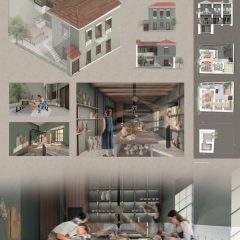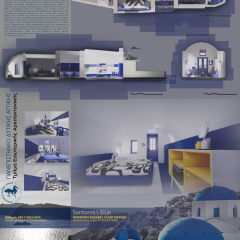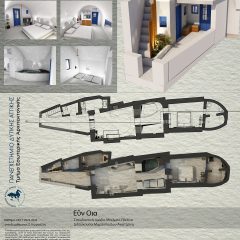Dr. Georgiadou Zoe, Tousi Evgenia, Dr. Michalopoulou Katerina
General
The epistemological content of the course focuses on the study, documentation, conservation and preservation of architectural monuments in conjunction with the subject of interior design. The course aims to support, nurture and develop the students’ ability to intervene and design interior spaces in historic-traditional-preserved buildings, integrating them into the modern environment and lifestyle. This is achieved through the theoretical analysis of the relationship between the architectural heritage of each historical period and the modern environment, the analysis of the legislative framework and the ways of protection, maintenance and reuse of architectural monuments, both at the national and European level. Also, with the acquisition of knowledge concerning the characterization of monuments in relation to specific historical periods, in ways and methods of maintenance and restoration, as well as in building materials and construction techniques that have been used. Special reference is made of Greek vernacular architecture, its association with the place, the climate, the particular social and economic conditions, the principles and the morphological choices that laid the foundations for sustainable design.
Programme aims
The central aim of the course is to introduce students to the process of synthetically investigating relationships between the old and the new, as well as the parameters that influence these relationships – historicity, memory, time, cultural identity. Deepening is sought through the development of a theoretical and practical background in the synthetic study of interior spaces in traditional-preserved shells, with an emphasis on morphology, structure, building typology, internal structure, decoration and materials that have been used. The relationship between interior architecture and history, preservation and memory, the object of protection and characterization of the latest architectural monuments, as well as the methods of restoration with the introduction of new uses are analyzed. Also, the fundamental terms and concepts, assemplied rules, declarations and international organizations that govern the restoration and maintenance of architectural monuments with a presentation of materialized projects, both in Greece and in Europe. The approach to the subject of application is made according to the modern scientific methods of analysis and documentation, as regards the management of the interior in existing historical buildings. A basic goal of the course is the cultivation of active individual participation, but also group cooperation, as well as interaction with the tutors. In addition, the process of disseminating the design result and resonating with local communities is cultivated through a work oral presentation.
Learning Outcomes: Knowledge and Understanding
The course is organized in two axes, theory (with lectures, critical placements and organized discussions), and application, in a synthetic design study topic, which work dialectically and gradually introduce design topics of increasing complexity.
In order to foster critical discussion and collaboration, students undertake group work with an essay on a topic related to the subject of the course, which is determined at the beginning of the academic semester by the lecturers.
Upon successful completion of the course, students will:
– have oversight of the social role of design in the context of the conservation and adaptive reuse of cultural heritage interiors.
– have the ability to analyze, understand and renegotiate with the necessary respect the aesthetic and functional dimension of interior spaces in cultural heritage buildings.
– acquire the ability to critically adopt basic conceptual principles in specific problems of reusing existing interiors of cultural heritage buildings.
– acquire the ability to gather and interpret cultural elements to form critical considerations that include reflection on aesthetic, ideological and social issues.
Bibliography
Crosi, G, (1998), The Conservation and Structural Restoration of Architectural Heritage (Advances in Architecture Vol 1), Southampton :Computational Mechanic Publications
Fram, (2003). Well-Preserved: The Ontario Heritage Foundation’s Manual of Principles and Practice For Architectural Conservation, Canada: Boston Mills Press Books.
Georgiadou, Z. (2024). Space and Sociological Approaches. An Interdisciplinary Perspective in Architectural Design. Kallipos, Open Academic Editions.
https://repository.kallipos.gr/handle/11419/10302
Jokilehto J, (2009). A History of Architectural Concervation, Oxford: Butterworth, Heinemann.
Semes S., (2009). The future of the past: a conservation ethic for architecture, urbanism and historic preservation, USA : W.W Norton Company.
Strike, J., (1994), Architecture in Conservation: Managing Development at Historic Sites (Heritage: Care-Preservation-Management), London: Routledge






